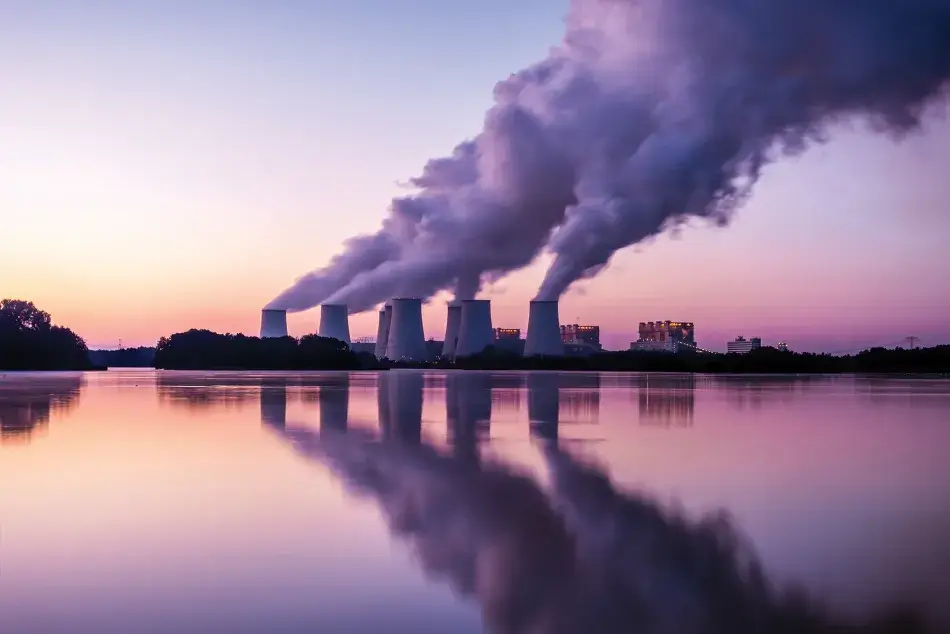
The Academy’s New Haven Program Committee in partnership with Yale University’s MacMillan Center hosted a conversation on national and international policies for slowing global warming that featured William Nordhaus (Yale University), recipient of the 2018 Nobel Prize in Economic Sciences. The program – supported by the George Herbert Walker, Jr. Lecture in International Studies at Yale – included remarks from Pinelopi Goldberg (Yale University; formerly, The World Bank Group) and Scott Barrett (Columbia University) as well as introductions from Steven Wilkinson (Yale University) and David Oxtoby (American Academy of Arts and Sciences). An edited version of the presentations follows.
2094th Stated Meeting | December 9, 2020 | Virtual Event
William Nordhaus is Sterling Professor of Economics at Yale University. In 2018, he was awarded the Nobel Prize in Economic Sciences for “integrating climate change into long-running macroeconomic analysis.” He was elected a Fellow of the American Academy of Arts and Sciences in 1984.

I would like to discuss four key issues concerning international aspects of climate change: 1) there has been very little progress in slowing emissions; 2) the challenge of incentives for low-carbon technologies; 3) the important role of carbon pricing; and 4) the need to combat international free riding with a climate compact.
Let’s begin with some facts about global CO2 emissions.
Over the last century, global CO2 emissions have risen at about 2.6 percent per year (Figure 1). If we look at the most recent period, we don’t see any major drop in emissions. In terms of decarbonization, we have seen a decline of about 2 percent a year over the period from 1990 to 2019.
Figure 1. Global CO2 Emissions
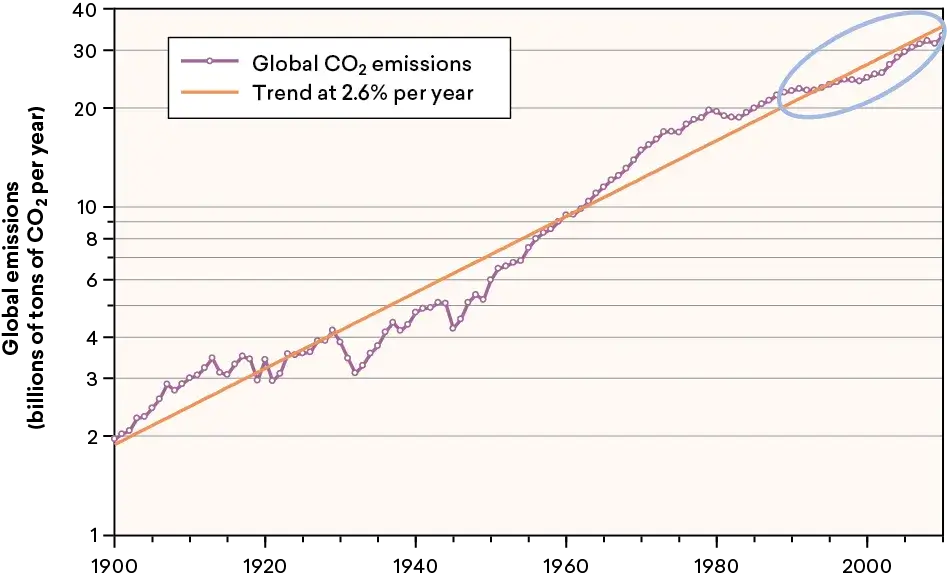
Source: International Monetary Fund and World Bank.
One of the surprising but slightly depressing results of the Paris Accord is that its ambitions are very low and that it will do relatively little to improve the global carbon output ratio at normal economic growth. It is clear that we are nowhere near meeting the goal of zero net emissions by the middle of the century (Figure 2).
Figure 2. Decarbonization: History and Future
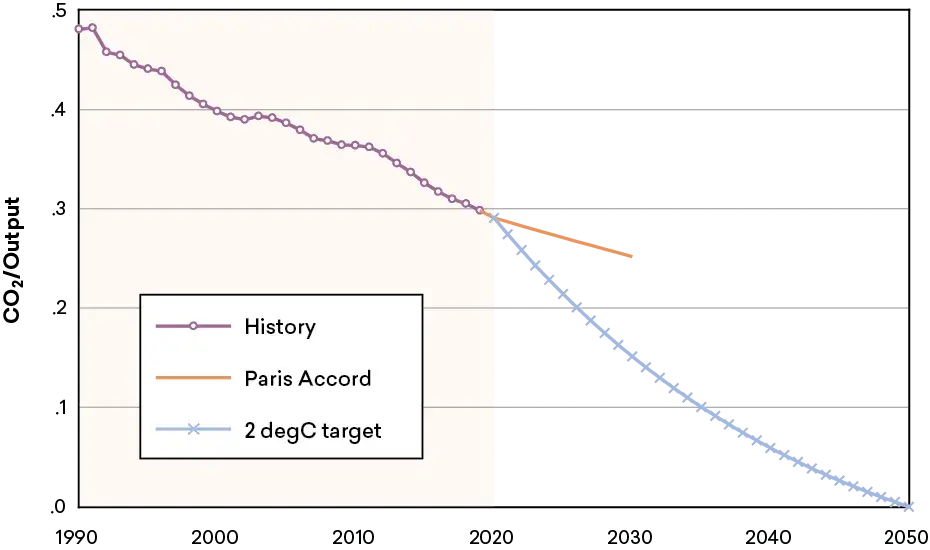
Source: William Nordhaus.
A question that I am often asked is whether it is true that the pandemic and the slowdown in economic growth have dramatically cut emissions. My answer is yes. And then the usual follow-up question that I am asked: is cutting emissions a useful way to slow economic growth? That is a very interesting question. We do not know what exactly has happened to emissions in 2020. We think they are down sharply, but we need to know what has happened to CO2 accumulations. What the data show is that even though there has been a sharp drop in emissions, there has been no similar sharp drop in CO2 concentrations. This reminds us of the great inertia in the climate and earth system. A sharp drop in output and a sharp drop in emissions will only make a small dent on concentrations and on temperature, partly because there is so much inertia in the earth system. This is a good reminder that this problem is a long-term one that cannot be solved overnight.
In terms of the role of economics in climate policy, I would like to focus on three things: 1) the inadequate investment in low-carbon technologies; 2) carbon pricing; and 3) the landscape.
One of the issues that does not get much attention is the inadequate investment in low-carbon technologies. It’s clear that we do not have low-carbon technologies that are sufficient to turn the world around. About 80 percent of our energy system is based on carbon and fossil fuels. There are at present very few solutions that are economical and adequate substitutes for existing technologies. This relates to the economics of innovation and invention, which is twofold. First, and the most important, is that the private returns on innovation are far below the public returns. So even though Bob Dylan just received $300 million for all of his songs, I am sure that the public benefit of that is far larger.
But for the environment and for climate change, things are worse because there is a double externality for low-carbon innovations. Not only is there the innovation externality because inventors cannot bottle and capture the full returns of their inventions, but there is also a climate impacts externality. For example, a green invention is doubly cursed because of the innovation externality and because the returns of lower emissions are not captured in the marketplace. So policies for low-carbon technologies require both fixing the climate externality and having special incentives for research and development on low-carbon technologies.
The way that economists have focused on fixing the climate externality is largely through carbon pricing. My second key economic insight is the importance of harmonized carbon prices across sectors and countries. A high price on CO2 emissions is the key to sharp emissions reductions because emissions are not caused by a single entity, a single government, or a single corporation but are the responsibility of billions of people in millions of firms, in thousands of governments, in hundreds of countries. You cannot hope to affect all of them without giving the appropriate market signals, but it requires more than that. To meet carbon targets in an effective way, the level of the carbon price should be harmonized so that the incentives across countries and across sectors over time are similar for similar groups. You cannot have vastly different prices for power plants versus automobiles, homes versus businesses, some countries versus other countries, some industries versus other industries. We would allow for different paths for poor countries, but we cannot make exceptions the rule.
Though all of this is idealized, I think it is useful to keep the ideal in mind. In reality, carbon prices are fragmented and very low. Figure 3 shows the carbon price landscape in 2019. We see countries ranked by their effective carbon price, from Sweden to the uncovered countries of the world. It should not come as a big surprise that the countries with the highest effective carbon price are European countries: Sweden, Norway, Switzerland, and France. There are a few others: British Columbia and California have reasonably high carbon prices. But as we see in the figure, 80 percent of the global emissions are from uncovered countries that have a zero-carbon price. If you take the weighted average of carbon prices across countries, it is a little under $2 a ton.
Figure 3. The Carbon Price Landscape, 2019
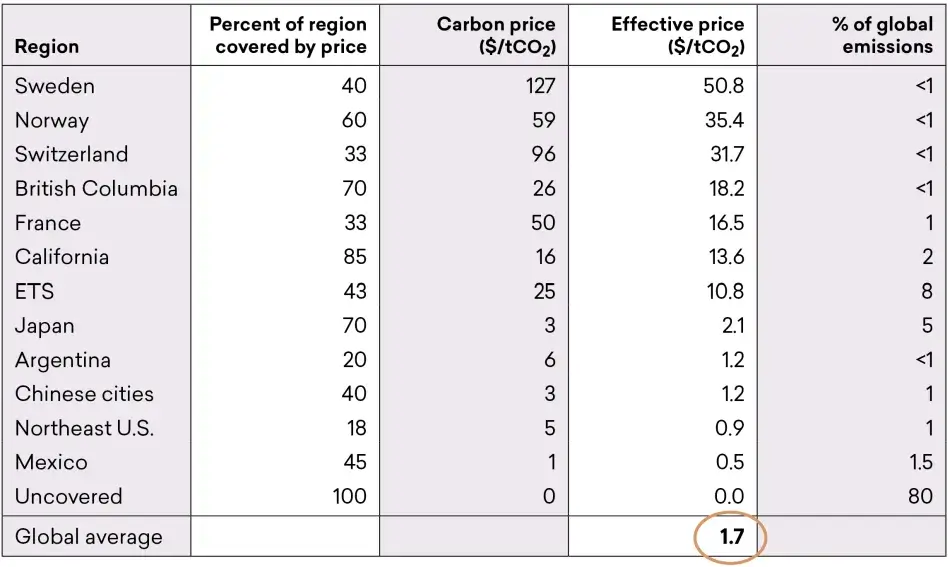
Source: World Bank.
I think it is fair to say that looking at the carbon landscape, we were doing virtually nothing as of 2019 to control CO2 emissions.
The third key economic insight is what I call the global free-rider problem. After thirty years of international climate policies, though we have accomplished much in terms of measurement and reporting, international policy is at a dead end. Climate change policy is hampered by what is known as the free-rider problem: the agreements are voluntary, there are no penalties for non-participation, and countries talk loudly but carry no stick. It is like riding on a trolley for free because there is no penalty for not paying. You can hop on at any point since no one is checking for tickets. But the problem is that no one then pays for the trolley system and there is underinvestment in areas where free-riderism prevails.
What is the reason for this rather pessimistic, or maybe realistic, assessment? It is based on both actual carbon prices, which are today low, and the minimal level of emissions reductions that we see in the data. So where do we go from here? A suggestion that I and others have made is what is sometimes called a climate compact to overcome free riding. The analytical approach behind this is the well-developed theory of clubs, which says that voluntary groups that have incentives for people to join are stable and effective. The EU is an example of a group that is most effective as a multinational club.
For climate change, a compact would include two features: One is an abatement requirement, such as a target carbon price, perhaps $50 per ton of CO2. The second is a penalty tariff for non-participants, say a 3 percent penalty tariff on all imports. We have done some modeling at Yale that suggests this could be an effective way to combat free riding. Figures 4 and 5 show supportable carbon prices for different tariff structures.
Figure 4. Carbon Prices Supportable in a Voluntary Regime

Source: William Nordhaus.
Figure 5. Carbon Prices Supportable under Different Tariffs
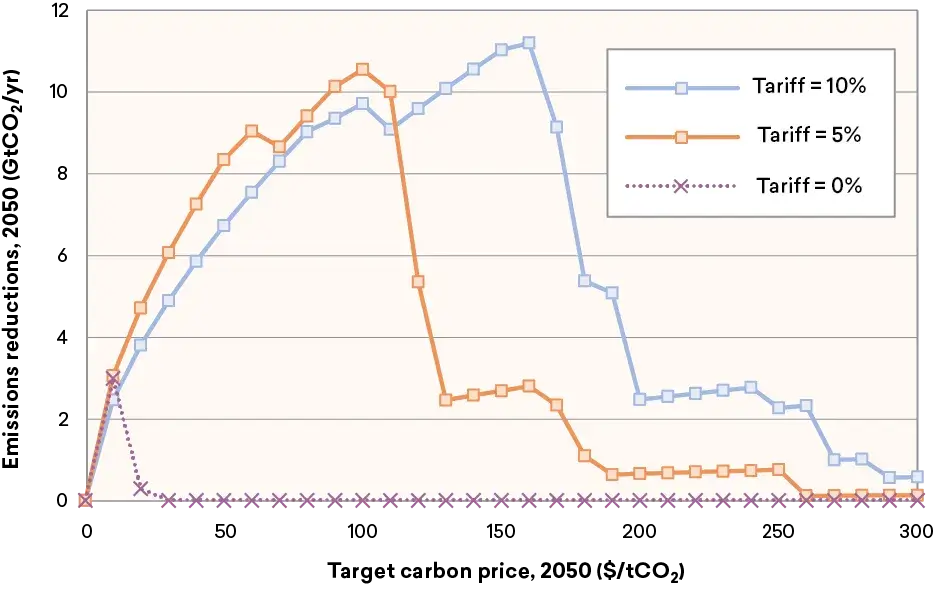
Source: William Nordhaus.
If we take the Paris regime or the Kyoto regime, what kind of reductions would be possible and at what carbon prices? Well, there would be some reductions possible, something like three billion tons of CO2 per year in the year 2050.
You can also look at different tariffs and see what kinds of tariff rates and reductions would be supported. What we see is that if the price gets too high, it is too costly to participate and countries drop out. If the price is too low, nothing happens. So somewhere depending on the tariff between $100 and $200 per ton of CO2 is the range at which you can support this system. But this by itself is probably not going to be sufficient to meet our goals, and the world will need rapid development of low-carbon technologies to make the transition less expensive and make a carbon compact more effective.
I will end by summarizing four key takeaways. First, the current climate architecture is ineffective. It has not solved the problem of high harmonized carbon prices and of reducing emissions. Second, low-carbon technologies are plagued by a double externality: the externality of invention itself and another externality because of the underpricing of carbon. Third, a key policy objective is to have high and harmonized carbon prices across countries, industries, and sectors. And fourth, strong incentive-compatible agreements can be supported with a climate compact: namely, mandatory carbon price policies plus tariff penalties for non-participants.

“The world will need rapid development of low-carbon technologies to make the transition less expensive and make a carbon compact more effective.”
Pinelopi Goldberg is Elihu Professor of Economics at Yale University and former Chief Economist of The World Bank Group. She was elected a Fellow of the American Academy of Arts and Sciences in 2014.

In contrast to my co-panelists, I do not specialize in climate change, but I do specialize in trade. As we have learned from Bill’s presentation, climate change involves cross-country externalities. There is a lot to learn from how trade policy has managed similar cross-border externalities over the years and what trade agreements have achieved. To start, let me give a very brief overview of the three basic points that I wish to make. First, while I share the assessment that so far the international climate architecture has been ineffective, I am slightly more optimistic about the future. I think there are reasons to believe that in the future international cooperation could play out better, and I will explain why. Second, I will be specific about how I envision international climate governance and what concrete steps we can take in the near future to make progress. And third, I will refer specifically to carbon pricing and to the proposal on climate clubs and tariffs.
Why am I more optimistic about the future? I believe that today we are in a very different place compared to thirty years ago, when many people did not believe in climate change (though some people still do not believe in it). Partly because of the weight of the scientific evidence and partly because of events that people have experienced, such as natural disasters, tsunamis, flooding, and so on, there is more acceptance of the fact that we are facing climate change, that it is not a low-chance event that isolated scientists emphasize, and that the risks are real.
Moreover, we are at a point where at least in advanced economies people are willing to trade off growth in pursuit of other objectives. Two years ago, if you were to tell us that the United Kingdom, Germany, most of Europe, and the United States would go into lockdown and take a huge economic loss in order to achieve some other objective (in this case, to save lives in the midst of the coronavirus pandemic), most of us would have considered that impossible. What this shows is that attitudes change.
Finally, one of the main problems with policy in the past was that many perceived a tradeoff between growth and addressing climate change. However, we are now at a point where policy-makers in certain parts of the world (mainly Europe) believe that addressing the challenges of climate change is not only compatible with growth, but can serve as the basis of a (green) growth strategy. It is therefore not surprising that Europeans seem more willing to embrace measures that address climate change. The policy in the United States is a different story, and I will come to that next.
What are the ways in which we can foster international cooperation? Here I am a bit pessimistic about the prospects of a truly multilateral solution to address the externalities involved in climate change, partly because multilateralism is all but dead now. The World Trade Organization is nearly defunct because of the actions of the United States, and many advanced economies are turning inward. To the extent that there is international cooperation these days, it takes the form of bilateral or regional agreements. And for climate change, this is insufficient because the problem is global in nature. A pragmatic approach needs to take into account who the big polluters are. If you look at where the emissions come from, it is essentially five countries: China, the United States, Germany, Russia, and India. If we want to move the needle on climate change, we need to start with these five countries. Taxing imports from the small players, from small developing countries, is not going to make a big difference.
Here, there are reasons for optimism and pessimism. As I mentioned, Europe is already on board and that is important. On the other hand, the United States, which is the second biggest polluter in the world, has been rolling back its environmental regulations. It is very hard to think about any form of international cooperation or any international solution that does not involve the United States. There is hope that with the new administration we can make progress. At the same time, there are big political economy issues that the United States faces no matter what the federal government does. For example, Texas relies on oil as do states such as Oklahoma, North Dakota, or Alaska. So, achieving consensus in the United States regarding the approach to climate change is challenging. This is a problem distinct from the issue of cross-border externalities.
As you may know, China is the biggest polluter in terms of total emissions. However, its per capita emissions are not among the highest in the world. Importantly, as the per capita income in China increases, people have started to prioritize the quality of life over growth. Many Chinese policy-makers now emphasize the so-called ecological civilization, which is one way to frame climate change. An optimistic vision going forward is that climate change is an area in which the United States and China could find common ground and cooperate. These two countries could pursue a joint agenda to reduce emissions, leaving aside geopolitical differences and the toxic rhetoric of the last few years. This would move the needle in climate change.
I do not think there is much hope that Russia will join these efforts given its heavy reliance on oil. India, with its very low per capita income, is prioritizing growth over climate change. Nevertheless, it is important to keep in mind that many developing countries face some of the worst consequences of climate change: air and water pollution, flooding, low agricultural yields, and desertification. It is important to bring them on board in the long run. But in the short run, one needs to take into account the many other challenges they face. In sum, I think a constructive approach forward would be to focus on the five major polluters (starting with the United States, China, and Europe) and try to foster an agreement among them.
What went wrong with the World Trade Organization (WTO)? There are quite a few lessons we can draw from its history that are relevant to climate change. The first is that the WTO was very effective in its initial stages because it included a number of like-minded countries that had similar objectives, that were at a similar stage of economic development, and that could agree on a common strategy. Eventually, trade agreements broadened their scope to include developing countries and many other areas that went beyond trade. At some point, the WTO became the victim of its own success. It became too broad and too heterogenous, with too many members pursuing different agendas and objectives. The WTO used to follow an all-or-nothing approach: all parties had to agree on all issues, which was paralyzing and debilitating. Recent reforms embraced a plurilateral system, in which a group of countries agree on a set of issues. These countries are generally like-minded. Other countries can join later if they want. They don’t face any penalties if they don’t join immediately, and they always have the option of joining later. This type of agreement allowed the World Trade Organization to make progress in some areas, for example, in trade facilitation and agriculture.
This approach could be applied to the area of climate change. To a certain extent, it is similar to what Bill proposed with climate clubs, but there is a crucial difference. There would be no penalties. But I know that in Bill’s proposal, it is crucial that the incentives be aligned and that there are tariffs that are used as penalties. This brings me to the third part of my comments on carbon pricing.
I agree with Bill that carbon pricing is the way to go. Naturally, economists embrace prices as the mechanism to efficiently allocate resources. The question is, why has this mechanism failed so far? One of the reasons is the political economy of carbon pricing. I mentioned the heterogeneity of preferences across U.S. states earlier. But also, if we think about the domestic context, the most common form of a carbon tax is a tax on gasoline. Raising the gasoline tax has not been feasible politically given the regressivity of the tax. Approximately two years ago, President Macron tried to raise the fuel price tax in France, and this is when the yellow vest riots erupted. It didn’t help that he tried to increase the tax at the same time when the wealth tax was abolished in France. What this shows is that framing, implementation, and bundling of carbon taxes with additional policies, potentially taxes or subsidies to make sure the tax is not as regressive as it usually is, is important and so far we have failed to deliver on that front.
My concerns about imposing tariffs on countries, some of which are too small to affect worldwide emissions and climate change, are twofold. First, tariffs have often been used for geopolitical reasons, as we have seen with the recent tariff war with China. Separating politics from science may prove hard. Second, in addition to China, there are other countries – for example, India, Bangladesh, Egypt, Pakistan – that are going to be disproportionately affected by tariffs. Some of these countries are not polluters; others are, like India. And as they grow, they will become even bigger polluters. So, while I am in principle in favor of carbon pricing, both domestically and internationally, I would like to conclude with two appeals.
First, carbon taxes should be implemented in a way that makes sure that those who are disproportionately affected or those who cannot afford to pay them, such as lower-income households and small businesses, are compensated. Second, we need to make accommodations for lower-income countries that are not at present in a position to take the steps necessary to reduce emissions.

“Partly because of the weight of the scientific evidence and partly because of events that people have experienced, such as natural disasters, tsunamis, flooding, and so on, there is more acceptance of the fact that we are facing climate change, that it is not a low-chance event that isolated scientists emphasize, and that the risks are real.”
Scott Barrett is Lenfest-Earth Institute Professor of Natural Resource Economics and Vice Dean of the School of International and Public Affairs at Columbia University.

In Paris in December 2015, (all) the world’s countries came together and agreed that climate change is a serious problem that requires them to act collectively to ensure that temperature change remains below 2 degrees Celsius relative to the pre-industrial level. Countries promised to make their own individual pledges for how they would help to contribute to meet this collective goal. If you look at the pledges that were made, they state that emissions are going to continue to rise, and there is no way to stabilize temperature change at 2 degrees Celsius or indeed at any level, as long as emissions keep increasing.
Why would countries go to all the trouble of meeting, agreeing on a collective goal, and making pledges, when those pledges guarantee that they will not meet their goal? We saw something similar with an earlier effort to address climate change multilaterally: namely, the Kyoto Protocol. Here too the world agreed on what to do. But the United States did not ratify the agreement. Canada did ratify the agreement, but it never passed legislation to meet it. When it went wildly off course and was sure to be in violation of compliance, Canada pulled out of the agreement, which under international law it is allowed to do; it is only obligated to fulfill the requirements of the treaty if it belongs to the treaty. Ultimately the agreement collapsed.
The behavior on display in Kyoto and Paris is consistent with the free-rider problem. What the Paris Agreement is doing is asking countries to make voluntary contributions. If people get to decide how much they are going to contribute, they will tend to contribute very little, and that is the situation we are in now.
But if you look at the history of international cooperation more broadly, the world has succeeded in some cases, and what is common about those cases is that countries are able to sustain cooperation when they choose to negotiate over something that gives rise to a phenomenon I am going to call “tipping.” With tipping, states are willing to play their part provided they have assurance that others are going to play their part, too. Once you get past a critical threshold of countries that will play their part, others will want to join in. You can think of this critical threshold as the tipping point for an international treaty. The problem with Kyoto and Paris is that neither agreement provides this assurance.
One possible way to do this is to link cooperation on trade to cooperation on climate change. This has been proposed before. President Macron of France, when he gave his address to the UN General Assembly in September 2019, said, “Let’s sign no more trade agreements with powers that don’t respect the Paris Agreement for climate change.” He was linking trade to participation in a climate treaty. Joe Biden is another example. Biden’s presidential campaign website says that Biden will condition future trade agreements on partners’ commitments to meet their enhanced Paris climate targets. The idea is already out there that we can link cooperation on trade to cooperation on climate. However, with linkage, we can expect that countries that were the target of these tariffs would want to retaliate. The whole trade system is built on reciprocity and so retaliation is expected. So, linkage could be risky.
Recent work that I have done with Astrid Dannenberg of the University of Kassell finds that linkage can work for a problem like climate change if a critical condition holds. And that condition is that the gain that a country gets from free riding has to be small relative to the gains it gets from avoiding a trade war. When that condition holds, linkage gives rise to a tipping phenomenon: there has to be a critical mass of countries that are in the agreement and that have promised to impose tariffs against nonparties. If that critical mass condition is met, then all countries are going to want to be inside that agreement to avoid the trade measures. What regimes give rise to this? There are two obvious ones: unilateralism and multilateralism. For unilateralism, it may be that just one, two, or three countries decide they want to do it. This may not achieve the required critical mass, causing the whole thing to collapse.
Under multilateralism, by contrast, participation must exceed some critical level in order for the agreement to enter into force. If this condition is satisfied, all countries will want to join. That is the ideal outcome: full cooperation on climate and no trade war.
Another way to look at this would be to focus on individual sectors. We can look at the linkages that have been tried in the past. One example is the Waxman-Markey Bill, otherwise known as the American Clean Energy and Security Act of 2009. There are provisions in that bill for trade measures to be used for trade sensitive sectors. Unfortunately, Waxman-Markey was never adopted; the Senate never voted on it so we do not know how it would have worked.
Another example is the European Union’s aviation directive, which focuses on one sector: international aviation. This legislation did enter into force, but immediately upon doing so the United States, China, India, and other countries threated retaliation. In response, Europe suspended its implementation of the directive.
There has been one multilateral attempt so far to link climate and trade, and that is an amendment to a treaty called the Montreal Protocol, the treaty that has protected the stratospheric ozone layer. The amendment to the treaty limits the emissions of hydrofluorocarbons (HFCs), a greenhouse gas that the Kyoto Protocol tried to limit but failed. Unlike Kyoto, however, the Montreal Protocol embodies a trade measure. And for this reason, there is a good chance that this amendment to the Montreal Protocol will succeed in limiting HFCs.
© 2021 by William Nordhaus, Pinelopi Goldberg, and Scott Barrett, respectively
To view or listen to the presentation, visit www.amacad.org/events/international-climate-gov.